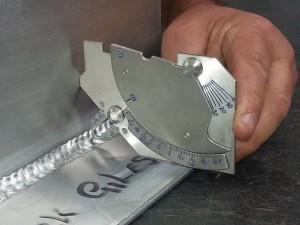The Impact of Welding Inspection Milwaukee on Project Success and Conformity
Wiki Article

Checking Out the Various Techniques and Criteria of Welding Evaluation for Getting Conformity and Dependability in Design Applications
The relevance of welding evaluation in engineering applications can not be overstated, as it functions as a critical safeguard for ensuring architectural integrity and conformity with industry criteria. Different methods, including aesthetic evaluation and advanced non-destructive screening methods, supply necessary insights into the quality of welds. Furthermore, adherence to well-known regulative standards such as those from AWS and ASME develops a structure for responsibility and excellence. The landscape of welding assessment is consistently evolving, triggering a better assessment of emerging methods and their effects for engineering integrity. What might these advancements entail for future tasks?Importance of Welding Evaluation
Welding evaluation plays an important duty in ensuring the stability and safety of bonded frameworks. The relevance of welding inspection can not be overstated, as it offers as a guard versus possible failings that could result from insufficient welding techniques.Moreover, welding assessment is important for keeping quality control throughout the welding process. It makes certain that the welds satisfy the necessary mechanical and physical homes required for their desired applications. Normal assessments likewise foster a society of liability and constant enhancement within welding operations, encouraging adherence to best techniques and sector criteria.
In managed industries such as manufacturing, aerospace, and building, rigid welding evaluation protocols are mandated to abide by lawful and safety needs. Ultimately, reliable welding assessment not only shields human life and home however likewise improves the durability and integrity of welded frameworks, making it an indispensable element of engineering and building.

Usual Welding Assessment Techniques
A range of examination approaches are used to analyze the high quality and integrity of welds, each tailored to identify certain kinds of problems. Among one of the most usual techniques is visual inspection, which includes a comprehensive evaluation of the weld surface area to determine visible defects such as splits, damages, and insufficient fusion. This method is typically the very first step in the inspection process because of its simpleness and cost-effectiveness.An additional commonly utilized method is radiographic inspection, where X-rays or gamma rays permeate the weld to expose internal problems. This strategy is specifically reliable for spotting porosity and additions within the weld material. Ultrasonic screening employs high-frequency sound waves to identify interior problems, providing an in-depth analysis of the weld's honesty.
Moreover, magnetic bit evaluation is used for ferromagnetic materials, permitting for the discovery of surface and near-surface issues by observing and using magnetic areas particle patterns. Dye penetrant testing includes using a fluid color to the weld surface area, exposing fractures and other interruptions upon evaluation (Welding Inspection Milwaukee). Each of these methods plays a vital role in making sure weld quality and compliance with industry requirements
Non-Destructive Checking Techniques
Non-destructive screening (NDT) strategies are important tools in the evaluation of weld high quality, permitting assessors to evaluate the integrity of welded joints without causing damage to the products. Numerous NDT methods are used to determine possible problems, ensuring that welds fulfill the needed requirements for safety and efficiency.Among the most common methods is ultrasonic testing (UT), which makes use of high-frequency acoustic waves to identify inner defects such as gaps or splits. Radiographic screening (RT) uses X-rays or gamma rays to generate photos of welds, revealing any type of discontinuities within the product. Magnetic particle testing (MT) works for finding surface and near-surface flaws in ferromagnetic products with the application of electromagnetic fields and contrasting fragments.
Liquid penetrant testing (PT) is another widely utilized technique that entails using a dye to the surface area of the weld, which leaks into any cracks, making them noticeable under ultraviolet light. Each of these techniques provides unique benefits and constraints, and the choice of an ideal strategy is important to accomplishing precise assessments of weld integrity. Inevitably, the application of NDT techniques significantly adds to the reliability and safety and security of engineering applications.

Regulative Specifications and Compliance
In the realm of welding useful source evaluation, adherence to regulatory requirements and conformity is paramount to make certain the safety and reliability of bonded frameworks (Welding Inspection Milwaukee). Various organizations, including the American Welding Culture (AWS), the American Culture of Mechanical Engineers (ASME), and the International Company for Standardization (ISO), have actually established standards that control welding methods and evaluation procedures. These standards supply a structure for quality guarantee, laying out the necessary qualifications for examiners and the approaches for analyzing weld stabilityConformity with these regulative requirements not just boosts the architectural honesty of welded assemblies however additionally mitigates risks connected with failings, which can have tragic repercussions. Inspections should be executed utilizing defined treatments, consisting of visual, ultrasonic, and radiographic see this here approaches, to make sure that welds meet defined standards.
Furthermore, adherence to these criteria is usually required by law, especially in sectors such as manufacturing, aerospace, and building. Routine audits and certifications are vital to keep compliance, therefore fostering a culture of safety and top quality within organizations. Eventually, regulatory criteria and conformity offer as the backbone of trusted welding inspection methods, ensuring that crafted structures satisfy both efficiency expectations and safety and security demands.
Ideal Practices for Welding Examination
While keeping conformity with regulative standards is important, applying ideal practices for welding examination further enhances the safety and honesty of welded frameworks. Efficient welding evaluation starts with thorough preparation, which consists of comprehending the certain requirements of each project and guaranteeing inspectors are trained in suitable techniques and standards.
Making use of an extensive assessment checklist helps to guarantee all essential facets are assessed, such as weld size, infiltration, and aesthetic flaws. Non-destructive screening (NDT) techniques, such as radiographic or ultrasonic testing, should be used where appropriate, giving a more comprehensive assessment of weld high quality without jeopardizing the stability of the materials.
Paperwork plays a substantial duty in ideal practices; preserving exact records of evaluations, consisting of photographs, test results, and conformity records, makes sure liability and helps with future analyses. Furthermore, promoting a culture of open interaction in between assessors and welders can bring about very early identification of potential issues, promoting immediate restorative actions.
Final Thought
In recap, the application of strenuous welding evaluation approaches and adherence to established standards are necessary for making certain conformity and reliability in design applications - Welding Inspection Milwaukee. Techniques such as aesthetic assessment, radiographic testing, and ultrasonic screening work as critical devices in maintaining and recognizing flaws quality control. By fostering a society of accountability and quality, companies can enhance the honesty and longevity of bonded frameworks, eventually contributing to the safety and efficiency of engineering tasks
Numerous techniques, consisting of visual evaluation and progressed non-destructive testing methods, provide necessary insights right into the top quality of welds.Welding evaluation plays a vital role in making certain the stability and safety of bonded structures.A selection of assessment methods are used to examine the quality and honesty of welds, each customized to identify certain kinds of Web Site problems.An additional commonly made use of technique is radiographic evaluation, where X-rays or gamma rays penetrate the weld to disclose interior defects.In the realm of welding evaluation, adherence to governing requirements and compliance is extremely important to make certain the security and reliability of welded frameworks.
Report this wiki page